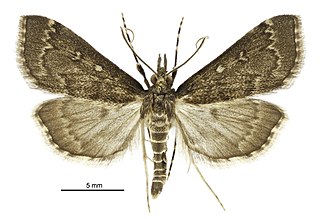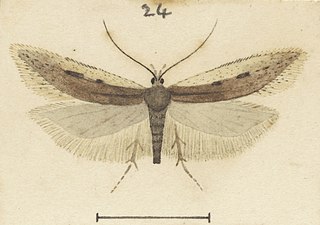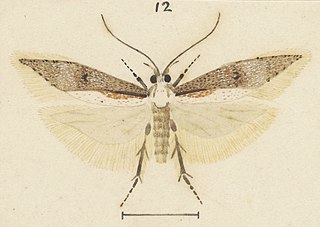
Proternia is a monotypic moth genus of the family Crambidae described by Edward Meyrick in 1884. Its only species, Proternia philocapna, described by the same author in the same year, is endemic to New Zealand.

Izatha apodoxa is a moth of the family Oecophoridae. It is endemic to New Zealand, where it is known from scattered localities in the southern North Island. This species is variable in appearance and comes in two forms, a grey form and a black and white form. In the grey form it is very similar in appearance to I. notodoxa and in the black and white form to I. katadiktya. At present the larvae and biology of this species is unknown.

Izatha metadelta is a moth of the family Oecophoridae. It is endemic to New Zealand, where it is known from the North Island only. It is rare north of Waikato and the Bay of Plenty.

Kiwaia aerobatis is a moth in the family Gelechiidae. It was described by Edward Meyrick in 1924. It is found in New Zealand.

Kiwaia brontophora is a species of moth in the family Gelechiidae. It was described by Edward Meyrick in 1885. It is found in New Zealand.

Kiwaia glaucoterma is a species of moth in the family Gelechiidae. It was described by Edward Meyrick in 1911. It is endemic to New Zealand.

Kiwaia heterospora is a moth in the family Gelechiidae. It was described by Edward Meyrick in 1924. It is found in New Zealand.

Kiwaia hippeis is a moth in the family Gelechiidae. It was described by Edward Meyrick in 1901. It is found in New Zealand.

Kiwaia lapillosa is a moth in the family Gelechiidae. It was described by Edward Meyrick in 1924. It is found in New Zealand.

Kiwaia lithodes is a moth in the family Gelechiidae. It was described by Edward Meyrick in 1886. It is found in New Zealand.

Kiwaia monophragma is a moth in the family Gelechiidae. It was described by Edward Meyrick in 1886. It is found in New Zealand.

Kiwaia plemochoa is a moth in the family Gelechiidae. It was described by Edward Meyrick in 1916. It is found in New Zealand.

Kiwaia schematica is a moth in the family Gelechiidae. It was described by Edward Meyrick in 1885. It is found in New Zealand.

Thiotricha thorybodes is a species of moth in the family Gelechiidae. It was described by Edward Meyrick in 1885. It is endemic to New Zealand.

Tingena ancogramma is a species of moth in the family Oecophoridae. It is endemic to New Zealand and has been found in the Hen and Chicken Islands, the North Island and the South Island. Adults are on the wing in summer and autumn and inhabit open areas of forest scrubland.

Tingena apanthes is a species of moth in the family Oecophoridae. It is endemic to New Zealand and found in the North Island. The adults are on the wing from October to December. It appears associated with Leptospermum species and it has been hypothesised that the appearance of the adults of this species imitates faded Leptospermum leaves.

Tingena hemimochla is a species of moth in the family Oecophoridae. It is endemic to New Zealand and has been observed in the North Island. Adults of this species are on the wing from December until March.

Trachypepla leucoplanetis is a moth of the family Oecophoridae first described by Edward Meyrick in 1883. It is endemic to New Zealand and has been collected in both the North and South Islands. It is the smallest moth species in the genus Trachypepla and the patterns on the forewings of adults are variable in appearance. It inhabits native forest and bush and the larvae feed on leaf litter. Adults are on the wing from October until February. T. leucoplanetis is regarded as being rarely observed and has been collected via the beating of foliage.

Trachypepla lichenodes is a moth of the family Oecophoridae first described by Edward Meyrick in 1883. It is endemic to New Zealand and has been found in both the North and South Islands. It inhabits native forest and adults of this species are on the wing from November to January. The adult moths are similarly coloured to native lichen species however this colouration is variable in the extent and depth on the forewings.

Trachypepla photinella is a moth of the family Oecophoridae first described by Edward Meyrick in 1883. It is endemic to New Zealand and has been collected in Wellington, Wainuiomata, D'Urville Island and Christchurch. The preferred habitat of this species is native forest and adults are on the wing from December until February.




















